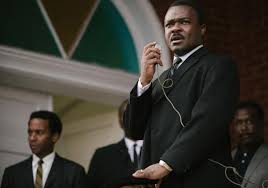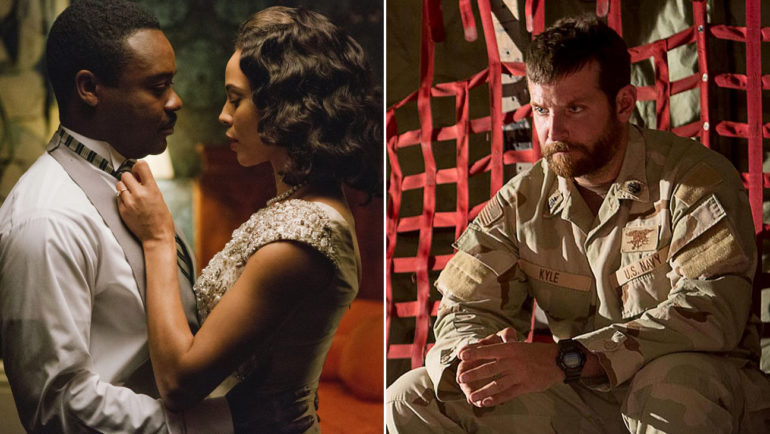*WARNING: This article contains minor spoilers.*
As the awards season rambles on, its controversies add flavour to the otherwise bland backslapping to which these things boil down. Two films in particular have been criticised for their portrayal of historical events. All publicity may be good publicity but, for American Sniper and Selma, their efforts are being given short shrift, particularly from outlets that should probably know better. The debates about historical accuracy and point of view detract from the work done by two talented directors. They may be at different stages of their careers, but Clint Eastwood and Ava DuVernay show their clear abilities in their latest offerings. Their use of history is a reminder that film cannot be treated as completely true reflections of the past, though some people have clearly forgotten that fact.
A lot has already been written about American Sniper, and a good deal of it came before its record-breaking opening weekend. Most of the articles written on the film have centred on the depiction of its leading man, Chris Kyle (played by Bradley Cooper). American Sniper is adapted from Kyle’s memoir of the same name, which details the late Navy SEAL’s four tours of duty in Iraq. The book was a bestseller, but Kyle’s descriptions and opinions on who he fought and why he fought them are not exactly nuanced. His description of enemy fighters as ‘damn savages’ seems ironic considering his kill count (160 confirmed kills, with more unsubstantiated), but it is perhaps more reflective of a mindset necessary to undertake these actions. If there’s one man who knows about putting such masculine hubris on a screen, if only to undermine it, it’s Clint Eastwood.

As discussed by Ronan Doyle at Next Projection, Eastwood is too smart a director to let Kyle’s descriptions and point of view be the be-all and end-all. In American Sniper, we get up close with Kyle in both war and peace. Eastwood has chosen Jason Hall’s adaptation of Kyle’s memoir to function as a journey through the pains of war and its after effects. On the battlefield, Kyle is not a gung-ho hero in the vein of the Man With No Name and ‘Dirty’ Harry Callahan. He’s remarkable at his job, one that clearly demands precision. However, at home his once-happy relationship with his wife (Sienna Miller) and their children bears the brunt of PTSD. War films are almost automatically damned/praised for any perceived political stance, so American Sniper was bound to attract attention from commentators. Eastwood is known as a card-carrying, chair-talking Republican, but his criticism of American military intervention and advocacy of gun control go against popular Republican views and the image cultivated by his earlier roles. After all, Dirty Harry’s most famous scene sees him taunting a wounded suspect with a handgun. Eastwood’s views are clear in American Sniper; there is nothing glorious about the war scenes, which are shot with urgency and a muted colour palette. At their height, they come down to simple kill-or-be-killed scenarios, with plenty collateral damage on both sides. Meanwhile, any sight of a gun in the film (which, given the story, is often) comes with a veiled menace. Kyle himself is taught to shoot as a child in early flashbacks, while he shows his son his firearms later on. The boys are enamoured by the weapons, but the guns loom in the shot, eclipsing the children. A late scene shows Kyle holding his own handgun in his home, with wife and children paying it no mind. The gun gleams in the light, drawing attention to itself. It foreshadows Kyle’s own death by gunfire, not in a war zone but near his home at a gun range. Eastwood is fascinated by the threats of war, especially when they are brought home. The fallout from Kyle’s PTSD is the anchor for the scenes when he returns from Iraq. He feels surrounded by the shellshock. A mechanic’s drill can be mistaken for gunfire when exposed to the latter for long enough. Kyle finds some solace with fellow veterans, the only ones who can relate to his traumas. Eastwood is focused on Kyle as a soldier, and what that does to him. It means he’s often battling the script to inject nuance, but the intent is clear.

The pros and cons of American Sniper can be summed up in one scene, most of which is shown in its theatrical trailer. The opening scene sees Kyle covering a door-to-door raid by US troops in a ruined Ramadi street. A woman and her child emerge from a doorway up the street, possibly carrying a bomb. The scene is incredibly tense, with Kyle considering whether or not to shoot the pair. Pregnant moments pass as he talks to a ranking officer over an earpiece, whilst the ground troops bellow orders at the mother and child. When it comes to killing these potential aggressors, Kyle is told the call is his to make. Eastwood milks the consideration Kyle gives to this call for all the tension he can get. However, the consideration he gives to this call seems at odds with the hunting of ‘damn savages’. As in the book, most of the aggressors get little-to-no character development, and other aspects are based on speculation. Kyle frequently exchanges fire with a talented Syrian sniper who medalled for shooting in the Olympics. In reality, no such Olympian fought in Iraq. Such problems are a basic issue with the script, but it’s clear that Eastwood was drawn to American Sniper by the chance to introduce even a little nuance to a story that seems myopic. It’s Chris Kyle’s story, but Eastwood’s telling gives it its edge.
Selma is not lacking in character, but director Ava DuVernay was faced with a similar problem to Eastwood: overcoming expectations. It’s a retelling of the events that led to the historic 1965 march from the town of Selma, Alabama to the state capital, Montgomery. The march was led by Martin Luther King (David Oyelowo in a powerful performance) to demand greater voting rights for African-Americans. A period piece biopic? Despite its relative lack of Academy Award nominations, Selma seems tailor-made for awards glory. Looking at fellow award-seekers The Imitation Game and The Theory of Everything, one has to consider how Selma avoids the rote perils of fitting a true story into a familiar narrative arc. Crass as it may sound, it helps that Selma touches on a hot topic; a number of high-profile cases involving African-American men being gunned down by police in apparent demonstrations of excessive force have brought race relations in the US back to the forefront of social and political debate.

The initial attempt to march from Selma was blocked by police, who used tear gas and baton charges to break up the marchers. Their heavy-handed approach was televised worldwide, leaving an indelible reminder of the struggle for integration. Wisely, Selma focuses on a particular series of events over a short period of time rather than attempt to tell King’s life story. The film has a great deal of historical records, footage and testimony from which to work. The question is: how closely does DuVernay cleave to the facts? Like Eastwood, she knows what story she wants to tell, and she knows exactly how she wants to tell it. The truth is adhered to where possible, even acknowledging King’s infidelities, but the minutiae of dialogue always require a degree of supposition. The most shocking changes might be to King’s speeches, which had to be altered slightly as the King estate had already sold the rights to the speeches for another proposed film.
Selma knows its history, and how the effects of that history are still being felt to this day. It knows that progress and recognition in such political and civil struggles come at a cost. An early scene sees King presented with the 1964 Nobel Peace Prize intercut with a depiction of the infamous church bombing in Birmingham, AL the previous year that killed four schoolgirls. The two events are not concurrent, but it pins the audience to the seat early on by declaring intent; subsequent events are framed in a context of violence and desperation. Soon after, the potential ramifications are shown, as Dr. King visits with President Lyndon Johnson (Tom Wilkinson) in the White House. A torrent of controversy has cropped up around the depiction of Johnson in Selma, with the New York Times suggesting Johnson becomes the villain of the piece. In Paul Webb’s script, and in the finished product, the worst that could be said about Johnson is he’s a pragmatist under pressure. The Voting Rights Act that extended the vote to all African-Americans of legal age, as keenly supported by Johnson, had already been signed into law before we meet Johnson in the film. His greatest issue is competing priorities. As he says to King, “You’ve got one big issue. I’ve got a hundred and one!” He has to balance the views and advice of all sides, though he is less than tolerant of the bigoted opposition of Alabama governor George Wallace (Tim Roth).

If Johnson is a reluctant ally of King’s, a more definite foe is the Federal Bureau of Investigation. Rather than displaying dates onscreen to illustrate events, Selma uses extracts from internal FBI reports that demonstrate the determination of J. Edgar Hoover (Dylan Baker) to disrupt the efforts of the ‘degenrate’ Dr. King. These reports include logs of events, meetings and phone calls, illustrating the covert lengths to which the FBI went. It’s perhaps a blunter portrait of Hoover than Eastwood gave us in his biopic J. Edgar, but it is founded in truth. More immediately dangerous is the local resistance in Alabama. The most memorable scene in Selma sees the first attempt to march thrown into chaos by a police baton charge. Tear gas and blows rain down on the protestors, while television cameras broadcast the scenes worldwide. People were struggling to breathe long before Eric Garner was put in a chokehold by police. DuVernay captures the energy and viciousness of the attack, with a power reminiscent of Pontecorvo’s The Battle of Algiers. This scene shows her incredible skill; the horrific nature of the police resistance is clear for all to see, but it never feels reactionary or over the top. When Spike Lee used the real video of the beating of Rodney King in the opening credits of Malcolm X, the lack of subtlety used to make the point is deafening. There’s no such pandering here; DuVernay credits her audience with enough intelligence to link the past events she presents with the strife of the present.
Both Eastwood and DuVernay know what they wish to achieve. They’ve shed light on stories many might have thought they already knew. Eastwood delivers a human story in the guise of a jingoistic war film. Conversely, DuVernay offers a message wrapped in a factually-rigorous biopic. Their skill is the key to their films’ successes, at least at the level of artistry. It is interesting to note that both films are nominated for the Academy Award for Best Picture, but neither has been nominated for Best Director. It’s not a good sign for their chances for the biggest prize, but what does it matter when their directors are the key to the films’ successes? Let the prizes fall where they may.
Both films are on general release now. Read Scannain‘s verdict on American Sniper here, and our review of Selma here.

